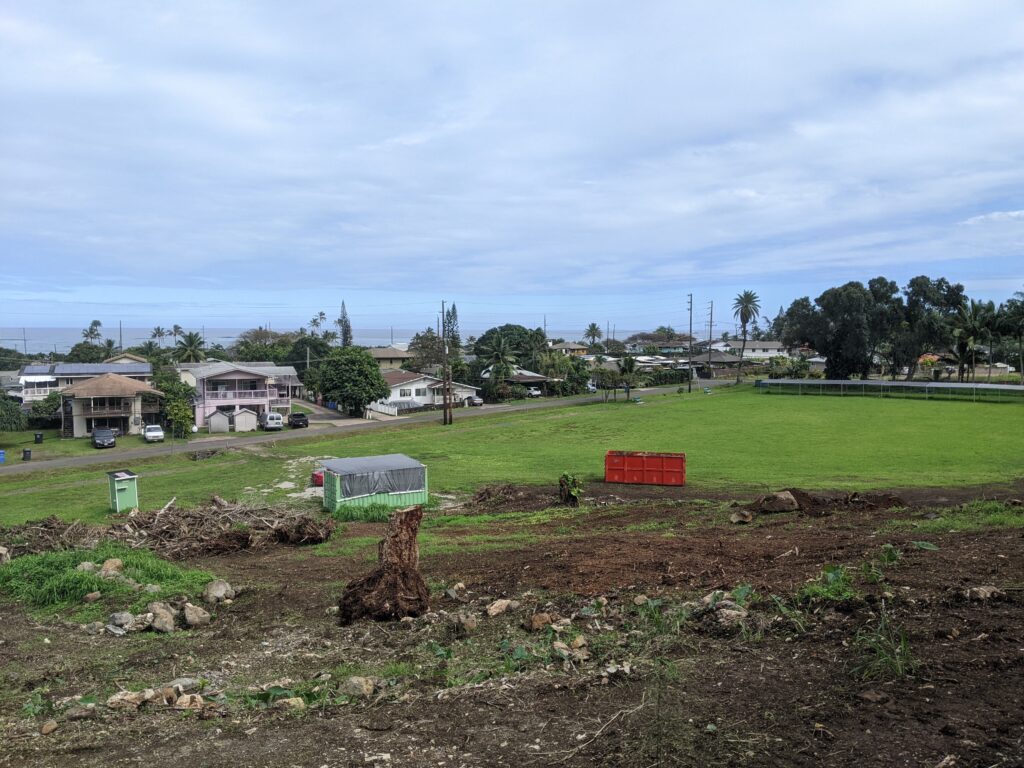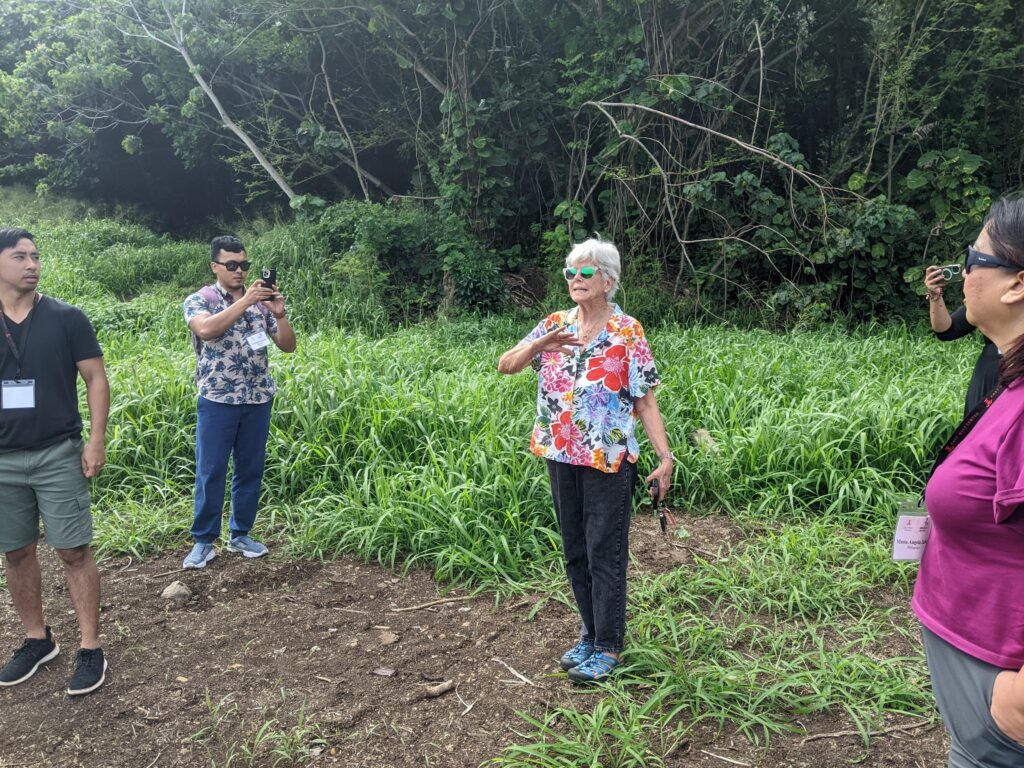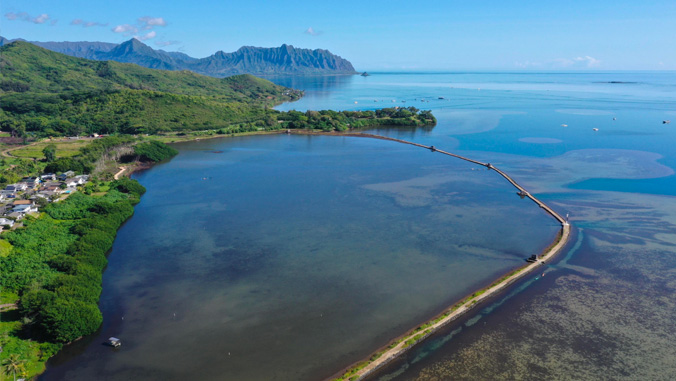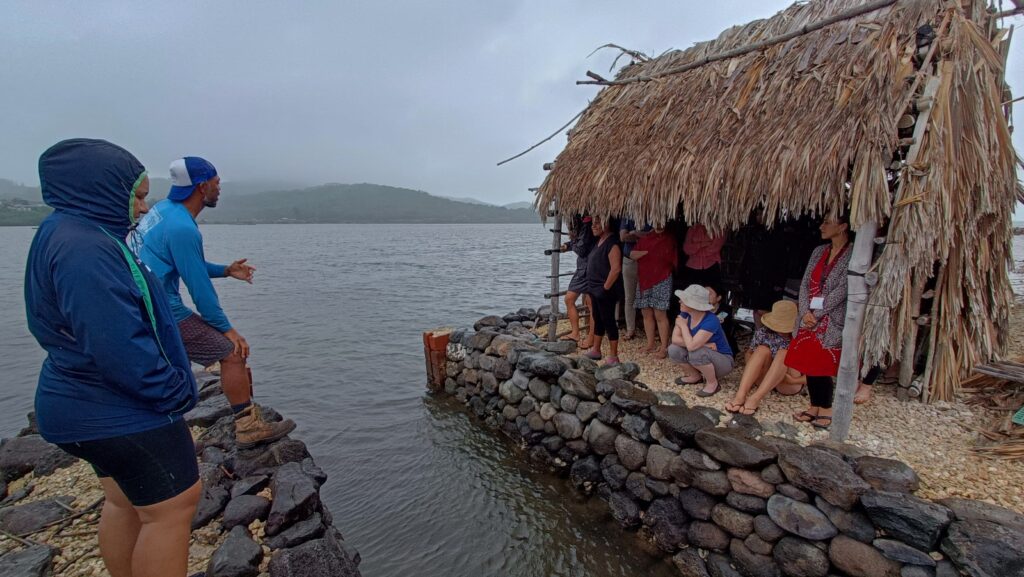<– Start at the beginning of the Climate Lab series
Hawai’i, Part 3 – In the Field, Continued
“In the beginner’s mind there are many possibilities, but in the expert’s there are few.”
– Shunryu Suzuku, Zen Mind Beginner’s Mind
I have participated in my fair share of climate change workshops and trainings over the years, and I expected something similar when I arrived in Hawai’i: lots of data about what we know about how climate change is impacting the planet, and how much we need to cut emissions by when to stay below a certain amount of warming. Maybe it’s because my work (and indeed, much of my country) is more focused on mitigation than adaptation, but I was caught off guard by a different approach this time. And, indeed, no one in our cohort of 16 climate leaders needed to be convinced of the dire nature of our situation – we were all there to learn what to do with that information.
I have also participated in my fair share of community tours to see how residents are 1) being impacted by a chronic issue and/or 2) organizing to address that issue. But since the beginning of COVID, and since taking over as the head of an organization (meaning that team members focused on outreach do the bulk of the interaction with frontline residents while I focus on running the company), I haven’t had nearly as much interaction on the community level as I used to. And I seem to have forgotten how valuable just a few minutes of listening can be – more than a few hours of research in some cases.

In last week’s post, [1] we went into depth about the potential public health impacts from wind turbines and the fear that residents of Kahuku experience as they watch their families get sick with vertigo, tinnitus, tachycardia, and epilepsy. Despite research that indicates that sensitive members of the population could be impacted by turbines sited closer than an appropriate distance, many residents feel that they were not – and are not – being taken seriously at various steps in what is supposed to be a participatory process. That visit showcased a prime example of what can happen when a community is not effectively involved or engaged in a project from the beginning (or at all).
Technology of the Future
Fifteen minutes down the road in Hau’ula, residents realize that they are at risk of losing their homes and being cut off from supplies, services, and even electricity for as long as a month in the event of a weather disaster. (Just a reminder that this community is on the same island as Hawai’i’s capital.) In order to ensure that the local communities have the support they need when – not if – they are isolated from the rest of the island, local non-profit organization, Hui o Hau’ula, [2] is leading efforts to construct a community resilience hub. Once operational, this building will be able to shelter 2,000 people during disasters; it is designed to withstand Category 5 hurricanes and is located uphill from the town, above tsunami and flood zones.
Hui o Hau’ula’s executive director Dotty (an energetic midwestern woman of retirement age, who reminded me very much of my godmother) joined us for one of our first classroom sessions earlier in the week, which involved small-group discussions to further examine topics presented by the governor. She and I were in the same group, and I was excited to visit her community a few days later. The governor’s illustration of how climate change compounds certain risks the islands already face was reflected in Dotty’s description of the scenarios they’re currently planning for on the North Shore. Governor and executive director alike stressed that effective communication about the details of a plan and the reasons behind it are critical for the success of any initiative.

This building, once funds are granted for construction, will not simply be a shelter that will sit there until it is needed. On the contrary, it will serve as the new home for the Hau’ula Community Center, which currently provides educational, social, cultural, professional, and other support programs for residents of all ages. In order to ensure that the project will be as successful as possible, residents have been involved in the design and planning of the hub, which will resemble an overturned canoe, evoking a method of shelter used in the past by native Hawaiians. [3] When we toured the five-acre site, we saw that even though excavation hasn’t started yet, the field is already being used for community events, such as a weekly farmer’s market, supporting a connection between residents and place.
Technology of the Past
During another visit later in the week, I was reminded that residents aren’t the only stakeholders to consider – the environment is as well. Being raised by an ardent conservationist, it feels silly to admit my tendency to overlook the environment in climate change considerations. But spending so much of my time as an adult focusing on how to get various people and organizations to work together productively, it can be easy to overlook the stakeholders that have no voice but play key roles nonetheless. And another 30 minutes southeast from Hau’ula in Kaneohe, we learned how one group at the He’eia Fish Pond is elevating environmental considerations by connecting modern communities with traditional fishing practices.
Fish ponds are a traditional component of Hawaiian culture, providing a food source when rough weather would otherwise make fishing in open water more difficult. The He’eia Fish Pond was built between 600 and 800 years ago with what would have required a significant amount of coordination throughout the community to create a 1.3 mile wall along the coast to enclose an area of approximately 88 acres. Within the pond, fresh water runs down from the mountains and mixes with salt water from the ocean. The ideal mix of water, which can be controlled through gates along the wall, creates an environment favorable to algae, which certain fish enter the pond to eat. Gaps in the gates are small enough to allow young fish into the pond but not to allow them back out when they get bigger – and once they are big enough to be trapped in the pond, they can be caught for food.
Unfortunately, several factors (both intentional and unintentional) rendered this example of Hawai’i’s unique form of aquaculture useless. First, a proper nutrient balance is essential inside the pond in order to grow the algae, and the pond originally utilized nutrients that came with runoff from farmland uphill. However, during the 20th century, more modern, extractive farming practices contributed to eutrophication in waterways – and in this particular fish pond. Compounding that problem, around the same time, mangrove trees were introduced to the island in an attempt to stem coastal erosion. While mangroves are incredibly useful in other parts of the world to maintain coastal areas and even purify water, they aren’t native to Hawai’i and began to destroy the pond’s infrastructure, rendering it uninhabitable for fish, as sediment buildup in the mangrove roots limited swimmable, livable space.

Image credit: [4]
Almost 25 years ago, a group of dedicated local volunteers began efforts to restore the pond. In the intervening time, a nonprofit organization called Paepae o He’eia was established not just to protect the pond but to utilize it as a location for community engagement and a topic for cultural education. [5] The mangroves are not gone (yet), but volunteers come to help remove them and maintain the pond while learning about traditional aquaculture practices. (Meanwhile, uphill, a separate nonprofit organization is focused on restoring traditional, regenerative agricultural practices, which addresses the other problem mentioned above.)
Our host Keli’i, the nonprofit’s assistant executive director, explained to us that the biggest thing the pond has to offer is not fish but experiential learning and connection to place. The fish population is not yet large enough to supply a regular food source, but fish from the pond are occasionally provided for cultural ceremonies and celebrations to enhance ties to Hawaiian heritage. There are invasive predator fish and mangrove crabs in the pond, but instead of eradicating them entirely, Paepae o He’eia has chosen to manage the populations and also create a continuous revenue stream by catching and selling them – they are apparently delicious.
Thoughts on Effective Engagement
In theory, we know that it is essential for community members to be involved in any project that affects them, but it was enlightening to see several different examples of how it has (or hasn’t) worked in practice. At the fish pond, we learned about community-led efforts to forge a connection with cultural roots by returning to a more traditional, less impactful way of living off the land and sea. At the resilience hub, we saw residents taking proactive steps to protect themselves against inevitable climate disasters, the risks of which are increasing as a result of fossil fuel use elsewhere around the globe. At the wind farm, we heard from families who have organized to respond to what they perceive as a threat to their health and safety, a threat that arrived without their input, but with the intention of creating more renewable energy for the island.

Image credit: Angie Zafra
In the context of my day job, I have long said that it should not be the responsibility of people bearing the burden of adverse health impacts to also have to take time, energy, and resources to advocate for themselves. Meaningful stakeholder inclusion from the start of any initiative is essential because when it is done well, the result can yield creative solutions and some benefits for everyone involved. When it’s not, the result can mean exploitative practices, exacerbated inequalities, and environmental and public health harms, including a sense of hopelessness, especially when it becomes clear that a participatory process is just performative. [6]
These problems are complex and frustrating, often lacking a clear path forward or a sense of forward progress. And at those times in my own work I have felt a certain measure of hopelessness myself, which isn’t something anyone wants to see in a leader. But concepts such as grief and hope featured prominently in group discussions as we wrapped up our time together on Oahu and reflected on our insights. And that is where we will continue next week.
Thank you for reading.
The Indo-Pacific Leadership Lab [7] is a program of the East-West Center, [8] with support from the Japan Foundation. [9]
As always, content on this blog reflects my personal views, and not those of any organization with which I am associated.
[1] https://radicalmoderate.online/climate-lab-hawaii-in-the-field/
[2] https://www.huiohauula.org/
[6] https://www.ehn.org/pipelines-mental-health-2667451778.html
[7] https://www.eastwestcenter.org/projects/indo-pacific-leadership-lab
0 Comments